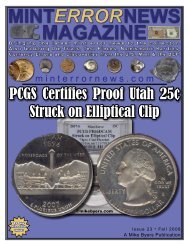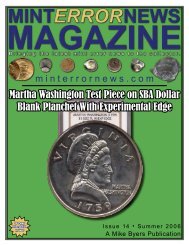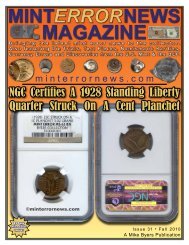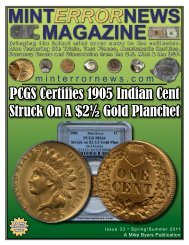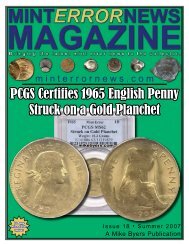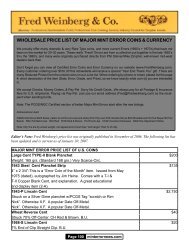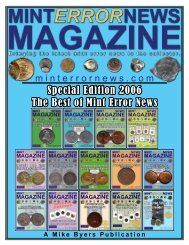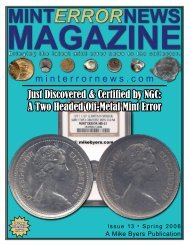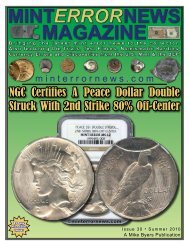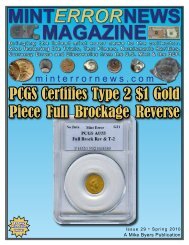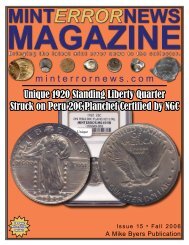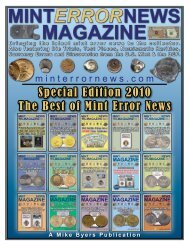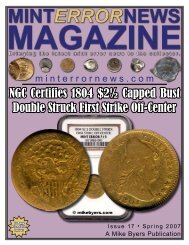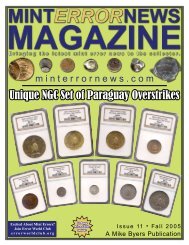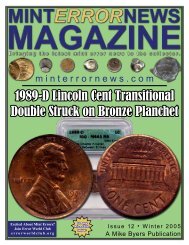Issue 1 - Mint Error News Magazine
Issue 1 - Mint Error News Magazine
Issue 1 - Mint Error News Magazine
Create successful ePaper yourself
Turn your PDF publications into a flip-book with our unique Google optimized e-Paper software.
Is a “Double <strong>Error</strong>” Large Cent<br />
More Valuable?<br />
nice group of error U.S. Large<br />
A Cents, including some 26<br />
off center pieces dated from 1795<br />
through 1855, was sold by Superior<br />
Galleries in the ANA auction sale<br />
of August 2002. One of these off<br />
centers, the 1829 piece shown below,<br />
is a “double error”, possessing an<br />
additional error feature, namely<br />
the clip that appears on the coin at<br />
approximately 6:30 on the obverse<br />
and 11:30 on the reverse.<br />
How rare is this “double<br />
error” large cent in comparison to<br />
“single error” off center large cents?<br />
To the best of my knowledge, no one<br />
has made a study of auction records<br />
and sales records that would help<br />
to answer this question. But even<br />
without this information, we can<br />
estimate the rarity by starting with<br />
some assumptions. First, we will<br />
assume that punching out the blanks<br />
(where a mistake may lead to a<br />
clipped blank) and striking the coins<br />
(where a mistake may lead to an off<br />
center) are independent activities in<br />
the sense that a clipped blank isn’t<br />
more likely to become an off center<br />
piece. Second, we will assume that<br />
less than 1 in 100 existing large<br />
cents are struck off center, and that<br />
less than 1 in 100 existing large<br />
cents have clipped planchets. If our<br />
assumptions are correct, the chance<br />
of finding a double error like this<br />
one is less 1 in 10,000 large cents (1<br />
in 100 times 1 in 100). Wow, what a<br />
rarity!<br />
So you think it sold for<br />
a bunch of bucks? This coin (lot<br />
2509) sold for just 33% more than an<br />
1830 (lot 2513) that lacked a second<br />
error feature but was otherwise<br />
very comparable. These coins<br />
were approximately the same grade<br />
Page 11 minterrornews.com<br />
by Henry Hilgard<br />
(good), had similar surfaces (nice),<br />
and were about the same percentage<br />
off center (20%). Both pieces were<br />
purchased by the same large cent<br />
dealer.<br />
What to make of the<br />
relatively small premium paid<br />
for the double error 1829? One<br />
factor may be that these double<br />
error pieces aren’t as rare as these<br />
numbers would suggest because our<br />
assumptions are off. But probably<br />
more important, no one seems to<br />
collect large cent “double errors”<br />
as a category, which is a way of<br />
saying that the marketplace just<br />
doesn’t place much value on rarity<br />
of this kind. All of which adds up to<br />
good news for error collectors who<br />
don’t have to empty out their bank<br />
accounts in order to own and enjoy<br />
an occasional coin with more than<br />
one error feature.



